ADENIUM SEEDS
Adeniums are easily grown from seed. It was the most common means of propagation in the 80's and is still used to raise millions of plants.Adeniums are easily grown from seed. It was the most common means of propagation in the 80's and is still used to raise millions of plants. Current uses of seed grown plants include:
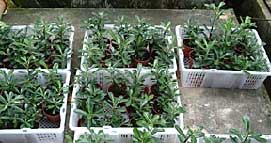 |
Multibranched seedlings from Malaysia for sale in Singapore supermarkets. |
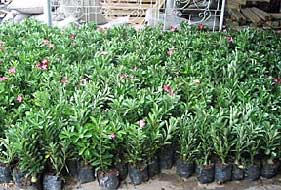 |
Seed grown Adeniums awaiting shipment to Europe by reefer container in Bangkok. |
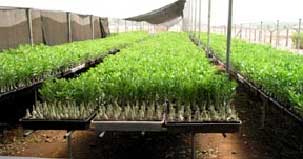 |
We raise more than a 100,000 seedlings for grafting. These are seedlings ready for top grafting: the ones in front have been cut back in preparation for the procedure. |
Seed Production:
We produce over a million seeds every year from around 2000 elite mother plants which are over 15 years old. This parent stock material has been selected over many years, after culling plants with characteristics of A. multiflorum and A. somalense, both of which produce excessively vigorous seedlings with poor caudex and flowering characteristics.
All seed is produced by hand pollination- this gives very high quality seeds with strong germination and growth characteristics.
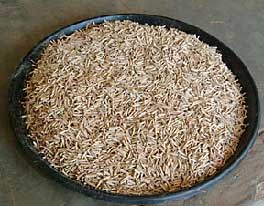 |
Seeds collected at the farm over 3 good harvest days, after basic cleaning. They will be be brought to the city for further cleaning, processing and counting and will be dispatched as soon as possible. |
Seed pods generally produce between 100-150 seeds per pair. Pollination to ripening time is approximately 75 days in summer and 90 days in winter.
Seed pods are harvested when they begin to split and seeds are cleaned of the tufts manually with great care. The cleaned seeds are then subjected to controlled post harvest processing. The bulked seeds are sorted for deformed or empty seeds and a small sample is taken for germination testing. Tests usually finish in 5 days. Seeds are then hand counted and packed in zip lock plastic pouches containing more than a 1000 seeds each- the exact number is adjusted, using the germination test results, to give at least 750 vigorous seedlings per packet.
Seeds are typically dispatched within days of harvest- fresh seeds gives germination in excess of 80%. As a policy, any seeds left for several weeks are sown for our own use. We have found that several months old seeds are equally good. Surprisingly, we recently discovered a large quantity of seeds harvested in early 2000, pushed to the back of the fridge. Planting it as usual just to see if we would get any germination, we discovered that even seed almost 3 years old will give 80% germination if sown and treated correctly.
Seed Testing:
A small sample (approximately 0.5% is taken from bulked seeds and tested. For this 200 seeds are placed in Multipurpose Trays containing moist kitchen tissue and the whole tray is enclosed in a new, clear polythene bag. No fungicide is used and the tissues are kept quite wet. After 5 days, only the vigorously growing seeds are taken as positive, the weak growers are not counted. A digital photo may taken for record purposes.
Special Adenium Seeds:
After several years of studying the results of specific crosses, we have identified specific combinations that give almost 100% seedlings with special characteristics, usually specific flower color.
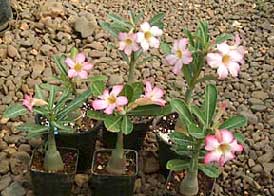 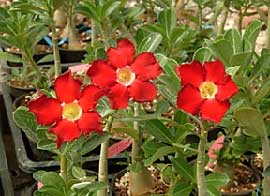 |
| Amongst the special seeds under trial: (left) seed line giving a high percentage of compact seedlings flowering at low height and (right) seed line with almost 100 percent deep red flowers. |
We are in the process of producing seeds for white and deep red colors, flowers with a light border as well as genetic dwarf plants. These are not F1 hybrid seeds in the sense that the parents have not been inbred sufficiently to get totally uniform offspring but rather selections that give a very superior range of seedlings.
Seedling Production:
We sow more than 100,000 seeds a year- below is our way of producing seedlings. It produces good results under our warm to hot conditions.
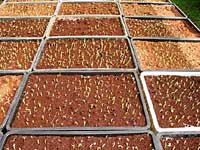 |
Seeds sown in trays just beginning to emerge. |
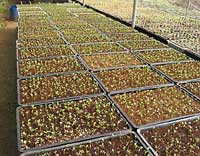 |
Seedlings about 1 week after emergence with expanded cotyledons. |
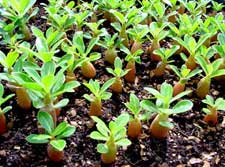 |
Approximately 2 months old seedlings with substantial, thickened stems ready for transplanting. |
Adeniums are programmed to cycles of good and poor conditions and responds to the latter with a kind of suspended animation state.
SEED SOWING IN TAIWAN:
Most growers in Taiwan sow seeds in plug trays: this has its advantages including ease of transplanting and little or no causalities at that time. We feel that bare rooting of seedlings at the time of initial transplanting under our system of sowing in seed pans like trays leads to root damage and subsequent seedling rots but the mortality is well under one percent and so we continue to use our system. The video below illustrates the technique used to sow seeds in Taiwan. Note the speed with which the expert does the job. Also, the depth to which the seeds are covered in this technique and the importance given to a thorough deep soak immediately after sowing.
SEEDLING QUALITY & FLOWERING:
The best quality seedlings are produced by growing them relatively slow and hard: this gives a compact seedling with a large, firm caudex.
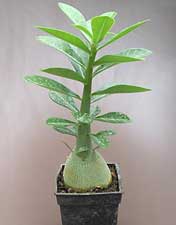 |
Perfect seedling for grafting: fat 5-6 cm caudex with narrow main stem which will accept a single scion top graft. |
The height and age at which seedlings flower is very variable, there being a definite genetic component here. In many cases seedlings will flower in 6 months from seed sowing but 9 months is common. Most should flower within a year under good growing conditions.
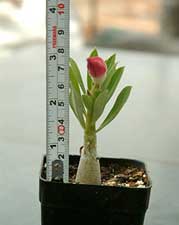 |
Smallest seedling to flower so far, at only 6 cm from soil to growing tip. |
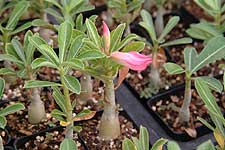 |
Odd seedling flowering well before the others: we have selected such seedlings and hopefully will be able to breed early flowering Adeniums from seed. |
To minimize time to flowering pot the seedlings in the largest convenient pot- the limiting factor here is often the problems with over watering of seedlings in too large a pot. To reduce risks some what, repot into sequentially larger pots as soon as root bound. A 10-12 cm pot will be large enough for the first flowering though 15 cm is better still.
SEEDLING PROBLEMS:
Some common problems with germination of Adenium seeds and growing the seedlings include the following. See Adenium Problems for details.
Damping off: Not uncommon, it is increased by poorly draining media. We do not pasteurize the media nor do we routinely use fungicides but we have problems so occasionally that it is not worth doing so.
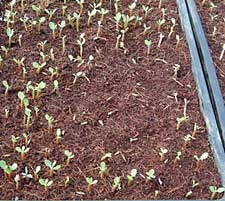 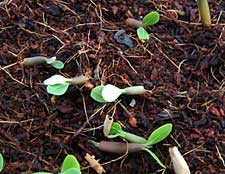 |
| Typical damping off pattern: starts with a few seedlings and spreads in a circle to involve more. The seedlings rot at ground level and topple over. Tops remain green and may sometimes re-root. This lot had poorly draining media because the ground Styrofoam was missing. |
Seedling rot: Probably caused by Pithium or Phytopthera, it is commonest when seedlings are transplanted. Again, we do not use any chemical controls as a rule, preferring to discard the small number that rot.
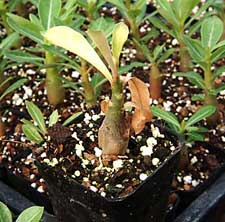 |
A seedling with root and caudex rot: such plants can be spotted easily by their yellow leaves. |
Caterpillars: These can really eat a lot of seedlings in a short time and once the terminal bud is chewed off, the plant will not grow.
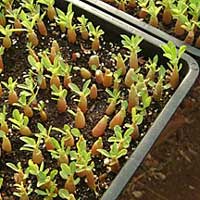 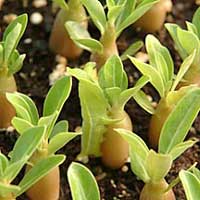 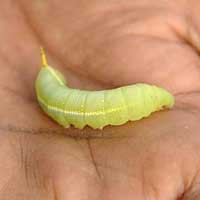 |
| Seedlings with all the top growth eaten away in the corner of the tray. The caterpillar keeps moving and was found amongst a batch of uneaten seedlings; it is the most common caterpillar found on Adeniums and get pretty large- this is a medium sized specimen. |
SEEDLINGS ODDITIES:
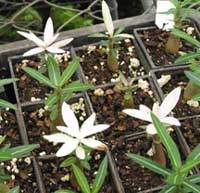 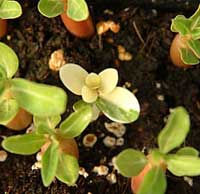 |
| Variegated seedlings. |
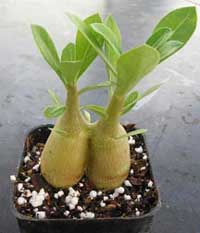 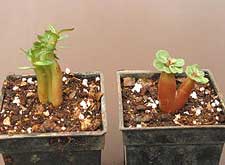 |
| Conjoined twins & triplets. |
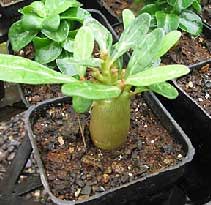 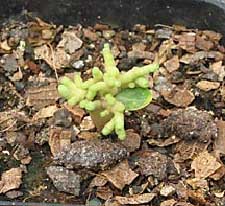 |
| Monstrose Adeniums. |

© Copyright Tropica Nursery 2026. All Rights Reserved.
Maintained by MiracleworX Web Designer Mumbai